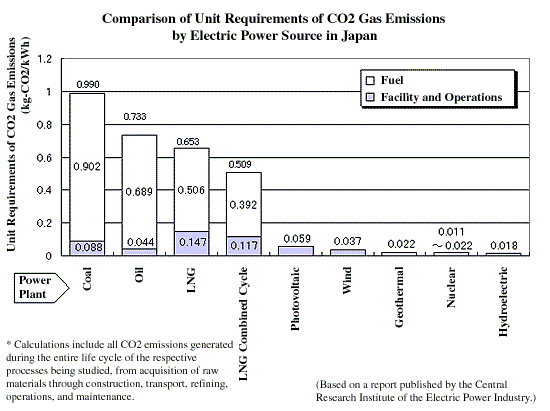Comments on the World Wide Fund for Nature's Report, "Climate Change and Nuclear Power"
Apr, 24, 2000
The Federation of Electric Power Companies (FEPC)
On April 6, 2000, the world's largest nature conservation NGO, the World Wide Fund for Nature (WWF), published a report titled, "Climate Change and Nuclear Power." This report was commissioned by the WWF to the World Information Service on Energy (WISE), an anti-nuclear organization with a worldwide network. Mycle Schneider, a WISE member, wrote the report.
For reasons that include the following, the report concludes that "an efficient greenhouse gas abatement strategy will be based on energy efficiency and not on the use of nuclear power."
1. Nuclear power generation indirectly produces greenhouse gases during the uranium enrichment process.
2. When consideration is given to both electrical power and heat supply, emissions for nuclear power plants are not that different from emissions produced by natural gas cogeneration systems.
Parts of the report have been released to the press.
Since we regard the report as significant in terms of the role of nuclear power generation, we have analyzed the report. As a result, we found several points (such as those presented below) that may cause misunderstanding.
1. "Nuclear power generation indirectly produces greenhouse gases during the uranium enrichment process."
・ The report makes an issue of the fact that greenhouse gas emissions are generated indirectly during the uranium enrichment process.
We would like to point out that this fact is widely known and is included in emissions calculations. When CO2 emissions are calculated for nuclear power, every aspect of the process is included, from uranium enrichment through facility construction, fuel processing, and transport ? just as for photovoltaic power or wind power installations. In fact, for every type of power generation, the Japanese electric power companies have always examined CO2 emissions generated during the entire life cycle of the process being studied, from acquisition of raw materials through construction, transport, refining, operations, and maintenance.
・ Looking at the graph cited in the WWF report (page 13), it is evident that CO2 emissions from nuclear power plants ? even including emissions generated indirectly by uranium enrichment and other processes ? are nearly equal to those of renewable energy sources, and are far lower than those for generation systems that depend on fossil fuels.
Similarly, calculations of CO2 emissions made by Japan's Central Research Institute of the Electric Power Industry (which include all energy that is consumed over the respective life cycles of various power generating systems) show that nuclear power is very effective with respect to controlling CO2 emissions (see graph below).

2. "When consideration is given to both electrical power and heat supply, emissions for nuclear power plants are not that different from emissions produced by natural gas cogeneration systems."
・ In one section that compares unit CO2 emissions from various energy sources, the report focuses on cogeneration systems, which supply both electric power and heat (see page 15 of the report). In doing so, the report concludes that unit CO2 emissions from nuclear power plants are approximately the same as those from natural gas cogeneration systems.
The comparison, however, is made between a natural gas cogeneration system and a system which supplies electricity through nuclear generation and heat by oil, which has higher unit CO2 emissionsthan natural gas. If the comparison were made instead with nuclear power systems linked with natural gas heat supply systems, CO2 emissions would be found to be approximately 30% less than those generated by natural gas cogeneration systems alone.
・ In addition, in Russia, Slovakia, Switzerland, Canada, and other countries, there are nuclear power systems that supply both electricity and heat. The unit CO2 emissions for these systems per kilowatt hour are at the same level or lower than biogas cogeneration, whose unit CO2 emissions are less than one-seventh the level shown for the nuclear + oil system, according to the report.
We will continue our efforts to achieve a balanced energy mix centered on nuclear power while taking into consideration the particular characteristics of each type of power source, including such factors as environmental conservation (beginning with global warming measures), the assurance of a stable and economical energy supply, and operational characteristics.
< Notes >
・ World Wide Fund for Nature (WWF)
1. The world's largest private conservation organization, established in 1961.
2. Headquartered in Gland, Switzerland.
3. Committees in 26 countries, with affiliated organizations in six countries.
4. Approximately 4.7 million individual and 10,000 corporate/organizational supporters (members and contributors).
・ World Information Service on Energy (WISE)
1. Anti-nuclear organization with a worldwide network; founded in 1978.
2. Headquartered in Amsterdam, the Netherlands.
3. Conducts research and surveys, provides information on nuclear power, and engages in direct anti-nuclear activities.
4. Author of the report: Mycle Schneider, director of the WISE-Paris office.